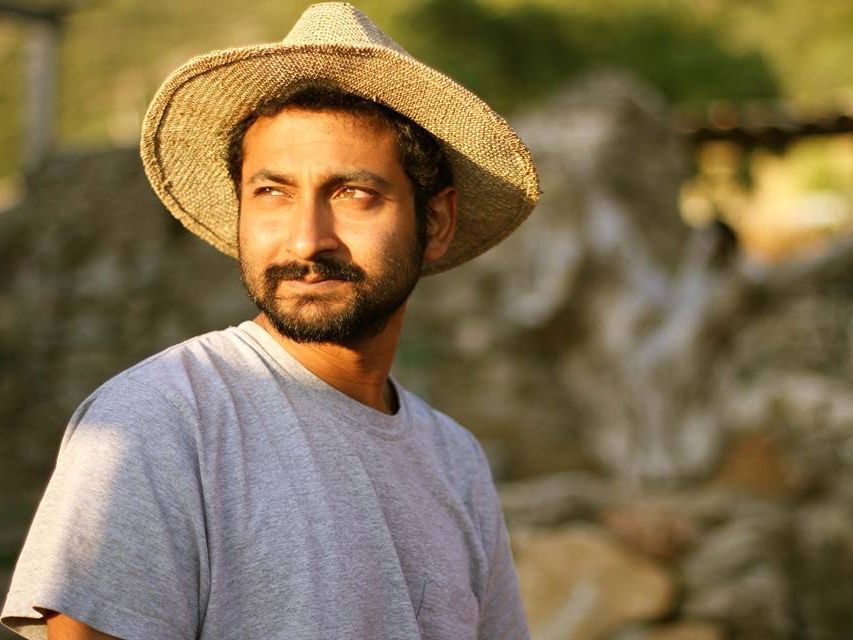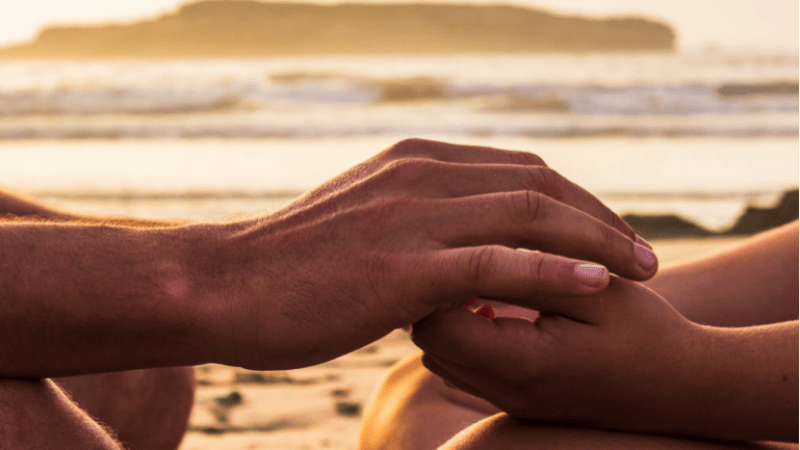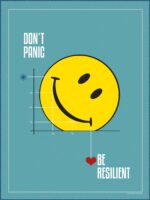I’m Feeling Optimistic About 2023, Thanks to Advice From The Dalai Lama’s Doctor I’m Feeling Optimistic About 2023, Thanks to Advice From The Dalai Lama’s Doctor

Words:
Molly Longman
Journalist
I’ll say it — I’m feeling cautiously optimistic about 2023. Let lightning strike if it will.
I feel this way, seemingly against the odds. I’m one of those masochists who reads the news faithfully each morning, taking in the passing of increasingly draconian laws, the “tripledemic,” mass shootings, climate change… and, don’t get me started on the capitalistic voyeurism-nightmare that was #christmashaul TikTok. I could — and have — written pages on these issues individually, so grouping them together almost seems flippant. But we live in a world where we’re constantly forced to skip from one tragedy to the next, like a rock on a lake that happens to be polluted, on fire, and full of genetically altered one-eyed fish.
Okay, okay… I know that doesn’t sound optimistic, but I’m feeling that way in spite of all of these things, even with the knowledge that 2023 will bring its own set of challenges. I’ve been doing a lot of thinking about a series of inspiring conversations I had back in 2022 with Barry Kerzin, MD, who happens to be the Dalai Lama’s physician. We spoke at The Wellbeing Summit for Social Change, and I watched him give a talk and workshop. By the end of the week, we were discussing politics and the concept of hell over tea.
Dr. Kerzin isn’t just a nice guy and a famous physician, but a Buddhist monk, an author, a professor, a nonprofit-founder, and the creator of the meditation app AIMIcare. He gets a lot done — and not just because he wears sneakers under his monastic robes. Dr. Kerzin is fueled, in part, because he’s learned through grief, training, and time to have a lot of compassion for people. And that mindset of loving-kindness has led to his pursuits. A lot of people (okay, me!) might initially roll their eyes at the phrase “loving-kindness” — which means putting out positive energy toward yourself and others, often through meditation. But after talking to Dr. Kerzin, it’s not hard not to feel like there might be something to it. In fact, my conversations with him resonated so much, I came back to the tapes of them while thinking about what I wanted to accomplish in 2023. I was especially struck by the way Dr. Kerzin had gone through difficult times — he lost his mother at a young age, and then his wife — and yet found a path that helped him stay steady and make the world a better, kinder place.
There are several nuggets from our talks that I’m taking into the new year with me, and I’ve laid them out here. Hopefully, they’ll speak to you too… and maybe even make you feel optimistic.
Start with self-compassion
The idea of self-compassion can seem antithetical to the whole “I’ll be better in 2023” shtick, which is why I’m starting with it. Whether your plan this year is to move your body more or improve time management, it’s difficult not to be hard on yourself the first time you skip a workout or forsake your to-do list. But negative self-talk can impact us in big ways, and even subconsciously affect our ability to be tolerant of others.
You can challenge the harsh voice inside your head by just noticing when it’s putting you down. Say, if you catch the voice telling you that you’re going to completely fail at all your New Year’s resolutions just because you had one setback. Just recognizing that you’re having these thoughts is a great first step on the path to self-compassion. Then, it’s a matter of redirecting those thoughts to more warmhearted ones (maybe think of an affirmation you’d give to your bestie if they were in the same situation, and write that down or remember it).
Dr. Kerzin also recommends working hard to notice if the negative voices in your head are really echoes of your past. If someone has told you, directly or indirectly, that you aren’t smart or attractive, it’s easy “to internalize those things,” he says. “And the more we do that, we make them our own. It becomes like our own voice saying those things, even though it didn’t start out that way. It was somebody else putting us down. We need to recognize that this is not ours. That gives us permission to slowly just throw that stuff out. Don’t buy into it.”
Another easy way to practice self-compassion: “Doing things we enjoy and that are meaningful to us — do them!” Dr. Kerzin says. “It’s okay, whatever it is.”
Be kind to others, too
Being nice to ourselves lays the groundwork for how we treat others. “Having self-compassion — giving more kindness and gentleness to ourselves — is a foundation,” Dr. Kerzin says. But, “if we stop at only being compassionate to ourselves, that’s when it can become selfish. The more we have compassion for ourselves, the more we can help others, engage with, and listen to them… In the same way that we’re getting in touch with our own pain, when we’re with someone and they are in pain, we can better figure out what we can do to help.”
We can put kindness into play in 2023 in myriad ways — just listening to a friend when they’re upset, volunteering, donating, forgiving someone, or giving a colleague the benefit of the doubt.
And, as with the circle of life, these acts of compassion towards others also end up being in service of ourselves. “Helping others is actually a wonderful way to help ourselves,” Dr. Kerzin says. “We feel good when helping others.” In other words: “Compassion is a win-win.”
Now, it’s easier to be compassionate to some than to others. There are people who get under our skin — and those we don’t even like. When you come across these folks, Dr. Kerzin says it can help your mindset to “make a distinction between the actor and the action. People have to be held accountable for their actions, but you can still have compassion for the person.” This is because, in Dr. Kerzin’s view, if someone is doing wrong, they’ll have to pay for their harmful actions in the future, one way or another. As Taylor Swift has said, “karma’s on your scent like a bounty hunter.”
Develop an inner safe space, even when the world outside is crazy
I mentioned my love of the news — there’s a lot of upsetting stuff screaming up at us from our phone screens. And immersing ourselves too much in such events can make us feel powerless. So much is still out of our control, no matter how much we protest, recycle, and call our Congresspeople.
That’s why it’s helpful to cultivate a space where you can go to find peace despite any external chaos that’s coming from your phone, community, coworkers, or even your friends and family. You can do this through mindfulness, meditation, or journaling. “There are various ways we can go inside in the present moment and observe what’s happening,” Dr. Kerzin says. “Ask yourself: What am I thinking? What am I feeling? What are my emotions? What’s my mood? What are my attitudes?… Rather than reacting, we are just observing. The more we take this approach, slowly with time, we’re less influenced by external affairs.”
Maybe you’re thinking: I have tried meditation and I’m not a fan. But it doesn’t have to be a formal “sit down and count your breath” kind of ordeal. It could be just taking a stroll in the park and noticing your body move. You could also try noticing the sounds and tactile feeling of doing the dishes, something my favorite meditation app Healthy Minds recommended to me. Or going to yoga or a concert or sitting in a church, mosque, or temple, and noticing how your five senses are responding.
“If we develop this practice to go inward and observe without reacting or judging, our inner life can let us develop a home; that home is in our hearts,” Dr. Kerzin continues, placing his hand over his chest. “It’s inside. And it’s something we can always return to, regardless of the climate catastrophe and the pandemics. It gives us a place of safety. A place of joy. And that’s something we can reach in the face of external calamities.”
That’s not to say we should stay in and ignore the pivotal issues around us. Knowing we have this safe place to come home to can give us the strength to turn outward again and fight for the causes we care about. “Having this home in our hearts gives us the strength, inspiration, and courage to go out and fight for what is right the next day,” Dr. Kerzin says. “Of course, ‘fight’ with love and compassion, ‘tough love.’”
Consider your “purpose” — not your goals
“When I was young — six, seven or so — there were two questions that were coming up for me regularly,” Dr. Kerzin says. “I’d ask, Who am I? and What am I doing here? These questions arose spontaneously. My life has been a lot about answering those questions,” Dr. Kerzin says. “I’ve come to the conclusion — it’s still an open question — but what I’ve come to is my purpose is to serve and help others.”
Having a purpose, whatever it may be, is different from having a “goal.” “Goals are temporary but a purpose is more meaningful,” Dr. Kerzin says. Now, having goals is by no means a bad thing, but they tend to be specific and time-related — I want to start volunteering or I’m going to run a half marathon this year — but “the purpose we’re talking about here is a deeper one underlying what’s meaningful and important about your whole life.” Dr. Kerzin prefers the “purpose” framing because he believes too much goal-setting can take you away from the present moment — meaning you can forget to appreciate the beauty of where you are right now.
If you’re not sure of your purpose, you can journal about the very questions Dr. Kerzin was asking himself as a kid: Who am I? What am I doing here? Once you know your purpose, it’s also important to ask: what tangible steps — both long- and short-term — can I take to achieve this?
Don’t put too much pressure on your purpose — it could be ever-changing and as simple as “make the lives of those I interact with a little better” or “do my part to raise awareness for a cause I care about.” When in doubt, “follow your heart,” Dr. Kerzin says.
Take the “middle way”
The “middle way,” is a Buddhist philosophy that involves steering away from extremes — from high highs and low lows in life. Dr. Kerzin happened to write a book about it. These days, many of us spend a lot of time creating highlight reels of our best lives — all the schnazzy shit we got for Christmas, for example. Or we’re venting about negative things to our friends and followers. This culture can make it harder to follow the Buddhist ideology, but not impossible.
“The middle way has different contexts,” Dr. Kerzin says. “It means on the one hand, in terms of our behavior, not to get too caught up with luxury. If we’re treated to something or buy something nice for ourselves, that’s fine, but don’t get too attached to it. Realize it’s not the only way to find happiness. It’s more of a way to find pleasure. But happiness is something in addition to pleasure, and it’s more lasting — subtler, more balanced and centered. But it’s also inside ourselves in our inner home.”
This comes back to having that “home” inside our hearts and minds — that concept helps us be a little less influenced by external trappings.
“Remember, pleasure comes from our senses: That painting is beautiful or this food is over the top,” Dr. Kerzin adds. “These are beautiful things. But they don’t last. They come. They go. If we don’t have them, sometimes we get pretty blown out of the water. We get depressed. But if we’ve cultivated this safety — this warm kindness, this love inside ourselves — we can develop this sense of a middle way, finding inner peace of mind.”
Don’t take yourself too seriously
Having a sense of humor makes life easier. And not taking yourself too seriously helps you avoid both acting arrogant and telling yourself you’re not enough. And if you do notice you’re freaking out over something small — or you’re feeling superior to others — Dr. Kerzin knows the best medicine: “Have a good laugh at yourself and move on.”
Last year, I left my conversations with Dr. Kerzin — and the uplifting Wellbeing Summit in general — feeling re-energized. I told myself I’d do a mindfulness meditation daily and really focus on the idea of compassion. I felt like I had a new lease on life. But, not long after the summit, the real world came crashing in like a tsunami and I felt like I was drowning in those dirty waters I mentioned before. Instead of morning mindfulness sessions, I’d jump out of bed and head straight to my desk, where I’d hunch over my laptop for hours. I was extremely hard on myself — I felt I was never doing enough. I wasn’t practicing compassion towards myself and, sometimes, towards others.
It’s true, I spent a good part of 2022 doing the opposite of everything I’d learned at the summit and from Dr. Kerzin. But there were also times — not every day, but often enough — in which I did come back to these ideas of compassion, mindfulness, and the middle way. I certainly was not always consistent, but I did make progress. I’m acknowledging those baby steps as an act of self-compassion.
So, I’m kicking off 2023 with my purpose in mind, hoping that I’ll grow in these concepts even more. That’s why I’m feeling good about it. And if the year is all uphill from here, I’ll employ another one of Dr. Kerzin’s lessons: I’ll laugh at myself for leading this story with the word “optimistic.”














































